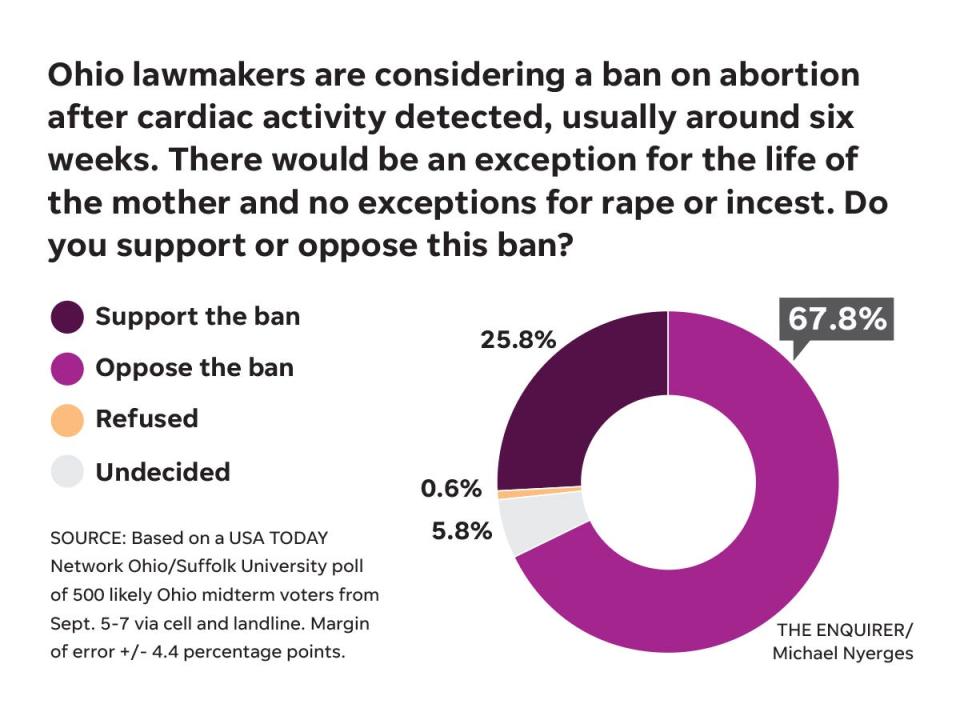Ohio needs a governor willing to lead not cave | Dispatch Editorial Board endorsement
- Oops!Something went wrong.Please try again later.
- Oops!Something went wrong.Please try again later.
- Oops!Something went wrong.Please try again later.
Ultra-conservatives in the Ohio General Assembly are driving the state so far right beyond the will of the people that the state is becoming unrecognizable.
Despite the moral and economic consequences, the current governor, Republican Mike DeWine, refused to use the power voters have given him to curtail those legislative efforts not supported by a majority of Ohioans.
Democrat Nan Whaley, his opponent and the former mayor of Dayton, is running on an agenda that puts Ohioans and our small businesses first. She recognizes the value of diversity, advocating for Ohio’s workers and quality education from the start.
Whaley will do what DeWine won't: stand up against those who would turn back the clock.
This is not to say DeWine has been completely ineffective — major strides have been made attracting business and on the issue of mental health for instance. But he should have spent more of the last four years checking off victories on areas he and the majority of Ohioans care about like curtailing gun violence and improving educational outcomes for kids.
Instead, DeWine has played second or third fiddle to lawmakers who were not elected by voters statewide.
Every likely voter who took part in a September USA TODAY Network Ohio/Suffolk University poll had heard of DeWine, giving him the same name recognition as former President Donald Trump.
DeWine has not set Ohio's tone or tamped down voices in his party who want to drive Ohio to the extreme when it comes to gun laws, gerrymandering and proposed legislation that would only deepen homophobia, racism, sexism, and transphobia (i.e. proposals that would outlaw classroom lessons about slavery and the evils of the Nazi party and on legislation that would require genital inspections for student athletes).
DeWine has been consistently run over or outshined by members of his own party — most notably State Senate President Matt Huffman.
More:Who's Matt Huffman? The Lima man running the show at the Ohio Statehouse
Whaley knows it.
"When we look at Mike DeWine, it's not that he's conservative or liberal. It is that he's weak," Whaley, said when she met with editorial board members from the Dispatch and other USA TODAY Network Ohio newspapers. "When John Kasich was the governor, John Kasich was in charge. When Mike DeWine becomes governor — the same party — Matt Huffman becomes in charge. So that's not necessarily an issue of party. It's an issue of leadership."
DeWine was invited to the meeting but declined to attend. He has also refused to debate Whaley, marking only the second time since 1978 that Ohio did not have a gubernatorial debate.
DeWine owes it to the voters of Ohio to defend his record.
Can Nan Whaley manage Matt Huffman and the Republicans?
Due in part to the sheer weakness of the statewide Democratic Party, extreme gerrymandering and strength of Republican leaders like Huffman, Republicans hold veto-proof majorities in the Ohio House and Senate.
The Ohio House is 65% Republican. The Ohio Senate is 76% Republican. Those percentages are far from where Ohio's citizens are.
The Ohio Supreme Court is controlled by Republicans and all elected members of the state executive branch are Republican.
That said, 42% of Ohioans who took part in the Pew Research Center's last Religious Landscape Study said they were Republican or leaned Republican. Another 40% identified as Democrat or leaning Democrat. Eighteen percent did not identify as either.
Ohio needs someone willing to rise to the challenge of balancing Ohio's lopsided branches of government.
One person can’t do it alone, but Whaley is not afraid to try.
Her campaign has raised millions less than DeWine's and she trails him significantly in poll after poll of likely voters, including an October poll by USA TODAY Network Ohio/Suffolk University that has him favored by slightly more than 17 percentage points.
Poll: Poll: Gov. Mike DeWine leads Democrat Nan Whaley by double digits
That said, even if Whaley is somehow able to overcome the odds and pull off a victory, we have no illusion that she could push her agenda through the Republican House and Senate, especially if they maintain their supermajorities. But she would fight the one-party domination that has created a litmus test that says even conservative Republicans like Mike DeWine are not conservative enough.
On paper, Whaley, a 46-year-old Indiana native, is no match for DeWine, whose career in politics started nearly 50 years ago.
But she is tough and with the power of the governor's veto may be able to stop some of the most extreme bills emerging from the Statehouse.
More:Here's how Ohio won a bid by Intel to build the world's largest chip factory
She helped steer Dayton through a horrific mass shooting in August 2019, just months after the area was smacked by 21 tornadoes in a single night.
Whaley showed she can operate under pressure and achieve bipartisan victories such as universal preschool approved by Dayton voters in 2016.
It will not be an easy task.
Our View: Our View: While your groceries go up, DeWine, LaRose, Huffman, Cupp waste millions to keep power
How did DeWine lose his party?
For a while there, it seemed DeWine was in control of his party and the state. DeWine has done a lot of good things for Ohio. He led efforts to bring jobs to Ohio and was one of the best governors in the nation when it came to leading during the early months of the COVID-19 pandemic.
More:Two years after COVID-19 pandemic began, Dr. Amy Acton reflects on her place in history
Confused and concerned Ohioans used small and large screens to watch the "DeWine and Dr. Amy Acton show"during broadcasts of daily COVID-19 press conferences.
DeWine was the first governor in the nation to close K-12 schools. He was even popular across the aisle with Democrats.
DeWine deserves credit for saving the lives of Ohioans.
But as the pandemic went on, he gave in to pressure from within his party.

Republicans in the Legislature grumbled and even drafted articles of impeachment against him. They claimed DeWine never consulted them about the impact of public health orders and was out of touch with small businesses, favoring large ones. They said he had overreached.
More:Should small businesses be closed by health orders if big ones stay open? Not anymore in Ohio
The Republican supermajorities in the Legislature eventually overrode the governor, seizing the right to repeal health orders issued by any Ohio governor or the Ohio Department of Health.
Since then, Huffman has asserted his will, not only controlling what becomes law and what does not (i.e. DeWine's gun plan), but also the narrative.

DeWine has repeatedly shown that he will be in lockstep with his party even when he said decisions were questionable as in the case of early redistricting maps for the General Assembly and Congress.
As a member of the Ohio Redistricting Commission, DeWine did not fight to ensure voting districts were drawn to represent the will of Ohioans who back in 2015 and 2018 overwhelmingly voted to break from partisan gerrymandering which gives one political party an advantage over the other.
He did not fight to maintain the state's strong COVID-19 response, leaving small businesses and school board members to make calls about public safety that should have come from him.
Likewise, DeWine has not fought nearly hard enough when it comes to gun control measures, something he pledged to do following the Dayton mass shooting which left nine innocent people and the gunman dead just 20 miles from DeWine's Greene County home.
Whaley was among the elected officials and community leaders on stage with DeWine at a vigil just hours after the shooting when the crowd drowned out the governor with chants of "do something."
Our view: Our view: Mike DeWine's promise to curb gun deaths now rings hollow
Dayton Mom to DeWine: I stood there, cried and believed you. You've let us down on guns.
DeWine did something. He caved, ultimately helping legislators make it easier for more guns to end up in the streets.
He signed the state's "stand your ground" law against the objection of a list of groups that included Ohio prosecutors, Ohio Fraternal Order of Police and a coalition of Ohio mayors that included Whaley, Columbus Mayor Andrew J. Ginther and then-Cincinnati Mayor John Cranley, who challenged Whaley for the Democratic nomination for governor.
DeWine signed into law a bill allowing legally qualified Ohio residents 21 and older to conceal firearms without training or permits.
Most recently he signed a bill which drops the training hours a teacher needs to be armed in school from 728 hours to about 24.
Whaley said the issue puts more pressure on already burned-out teachers.
What impact can an unchecked legislature have on the economy?
Not all is doom and gloom as Ohioans head to the polls to vote for DeWine or Whaley. Recent news that Honda, Ford, Intel and other companies plan to invest billions in the Buckeye State offers hope for our economic future.
About 3,000 employees will work at Intel's two Licking County plants. The $20 billion investment includes $2 billion in economic incentives from the state.
More: Ohio approves $650 million in Intel incentives
DeWine's economic agenda includes bringing manufacturing back to Ohio. According to his campaign site it will also focus on "investing substantially in career education, job training, and workforce development to upskill Ohio workers," points connected to Intel and the tech sector.
He deserves praise for his work to hook Intel, a very big fish.
But so do a long list of players involved in the deal including One Columbus, the city of New Albany, JobsOhio and the Biden Administration, which pushed the new CHIPS law which paved the way for Intel's buildout.
Time will tell if the impact of the Intel deal is felt outside of the Columbus area, a region already facing the joys and pains that come with rapid growth.
Whaley says politicians have ignored people in small communities as evident by cuts to the local government fund and lack of funding for "Main Street corridors."
"We've seen this as decline of our smaller communities — mostly county seats over the past three decades. And we've had this attitude of that's just the way it is. I just disagree with that," she said. "We can have real investment in these communities."
The planned investments offer hope but do not cancel out economic realities that include high inflation, an affordable housing crisis, a loss of 7,600 jobs in September (the most of any state) and looming fears of a recession economists say will likely hit in 2023.
Instead of a focus on solutions to those issues, Republican lawmakers are pushing an unwelcoming culture agenda that threatens to dash hopes that the rustbelt pejorative will no longer be associated with this great state.
Someone needs to head them off. We know there can be economic consequences to such legislative decisions.
In August, Eli Lilly, one of Indiana's largest employers, told the Indianapolis Star that the state's new restrictive abortion ban would hinder the company's ability to attract diverse scientific, engineering and business talent to Indiana and force it to expand outside of the state.
At a recent Detroit Economic Club forum, Michigan Gov. Gretchen Whitmer said that if voters there enshrine abortion rights into that state's constitution in the upcoming election, she'd start “stealing headquarters” and "luring" and "cultivating" workers from Ohio and Indiana.
"Go to Purdue and talk to every woman engineer as well as Ohio State and bring them to Michigan where you can have full rights to make your own decisions about your health and your body and a great job," she said.
What impact will abortion play?
Whaley, the first woman to win a major party gubernatorial nomination in Ohio history, has made abortion rights central to her political platform that also includes clean energy jobs and "growing the jobs of the 21st century, supporting Ohio entrepreneurs, and raising wages for all Ohioans."

She drew a connection between abortion and the economy when she met with us.
Whaley emphasizes that polls show Ohio voters favor abortion rights, and that DeWine has a long track record of being anti-abortion, having signed the state law which bans abortion after fetal cardiac activity is detected, usually around six weeks.
Poll: Poll: 2 of 3 Ohio adults oppose banning abortion at 6 weeks
Whaley wants Roe-era abortion rights to become Ohio law.
"This is going to have a direct impact on our economy," she said. "Women (who) are deciding to have children or not have children, don't want to do that in Ohio because it's dangerous ... I hear daily from moms or women themselves that are like, my daughter is leaving, or I've got to get out of here."
Nearly 70% of likely Ohio voters who took part in a recent USA TODAY Network Ohio/Suffolk University poll opposed Ohio's new abortion law. Exceptions for victims of rape or incest were supported by 84%.
Still lawmakers are pushing for even more restrictive legislation than what DeWine signed.

The case of a 10-year-old Columbus rape victim who received an abortion in Indiana after Roe v. Wade was overturned has drawn even more attention to the lack of exceptions for incest and rape in Ohio's now court-paused abortion law.
More:Ohio deserves a statesman in US Senate not a Trump kiss up| Who our board thinks should win
The governor dodged a question about his support of a near total abortion ban during a recent meeting with the Cleveland.com/The Plain Dealer editorial board, indicating that the ball would be in the Legislature's hands in light of the fact that the issue can be taken to voters.
"I want to protect human life. I'm not going to deviate," the 75-year-old from Yellow Springs said. "But we also have to understand and the Legislature, I'm sure is going to consider the fact that, in Ohio, we have the right to referendum."
More:Here's how Ohio won a bid by Intel to build the world's largest chip factory
Advocates for abortion access are preparing to ask Ohio voters to approve a constitutional amendment for abortion rights. Adding exceptions for rape and incest to the heartbeat bill could impact that efforts.
Ohio needs a governor that leads
Times will be challenging for whomever Ohio chooses as governor.
DeWine has demonstrated a reluctance to lead by not standing up to extremists in his own party.
By not doing so, he is failing the people of Ohio and is enabling those pushing divisive and dangerous agendas that can have dire economic and social repercussions.
Ohio needs a balance of power in our state government to align to where the public stands.
Nan Whaley understands the issues Ohioans face and is willing to fight to solve them.
She will do what Mike DeWine refuses to do.
She will stand up for all Ohioans.
She will lead.
We urge you to vote for Nan Whaley for governor.
Endorsement editorials are our board's fact-based assessment of issues of importance to the communities we serve. These are not the opinions of our reporting staff members, who strive for neutrality in their reporting.
This article originally appeared on The Columbus Dispatch: Why Columbus Dispatch's ed board endorsing Nan Whaley over Mike Dewine

